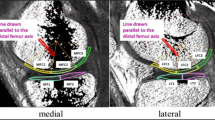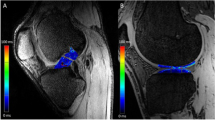Abstract
Purpose
To analyze the morphological change in the cartilage of the knee after anterior cruciate ligament (ACL) injury by comparing with that of the intact contralateral knee.
Methods
A total of 22 participants (12 male and 10 female patients) who had unilateral ACL injury underwent MRI scan of both the injured and intact contralateral knees. Sagittal plane images were segmented using a modeling software to determine cartilage volume and cartilage thickness in each part of the knee cartilage that were compared between the ACL-injured and the intact contralateral knees. Furthermore, the male and female patients’ data were analyzed in subgroups.
Results
The ACL-injured knees had statistically significant lower total knee cartilage volume than the intact contralateral knees (P = 0.0020), but had similar mean thickness of total knee cartilage (not significant: n.s.). In the male subgroup, there was no significant difference in cartilage volume and thickness between normal and ACL-injured knees. In the female subgroup, the ACL-injured knees demonstrated statistically significant difference in total knee cartilage volume (P = 0.0004) and thickness (P = 0.0024) compared with the normal knees. The percentage change in the cartilage thickness in women was significantly greater than that in men.
Conclusion
Cartilage volume was significantly smaller in the ACL-injured knees than in the contralateral intact knees in this cohort. Women tended to display greater cartilage volume and thickness change after ACL injury than men. These findings indicated that women might be more susceptible to cartilage alteration after ACL injuries.
Level of evidence
III.





Similar content being viewed by others
References
Brophy RH, Zeltser D, Wright RW, Flanigan D (2010) Anterior cruciate ligament reconstruction and concomitant articular cartilage injury: incidence and treatment. Arthroscopy 26:112–120
Buck RJ, Wyman BT, Le Graverand MP, Wirth W, Eckstein F, A9001140 Investigators (2010) An efficient subset of morphological measures for articular cartilage in the healthy and diseased human knee. Magn Reson Med 63:680–690
Clark AL, Leonard TR, Barclay LD, Matyas JR, Herzog W (2006) Heterogeneity in patellofemoral cartilage adaptation to anterior cruciate ligament transection; chondrocyte shape and deformation with compression. Osteoarthritis Cartilage 14:120–130
Cotofana S, Eckstein F, Wirth W, Souza RB, Li X, Wyman B, Hellio-Le Graverand MP, Link T, Majumdar S (2011) In vivo measures of cartilage deformation: patterns in healthy and osteoarthritic female knees using 3T MR imaging. Eur Radiol 21:1127–1135
Ding C, Cicuttini F, Scott F, Cooley H, Jones G (2005) Association between age and knee structural change: a cross sectional MRI based study. Ann Rheum Dis 64:549–555
Eckstein F, Cicuttini F, Raynauld JP, Waterton JC, Peterfy C (2006) Magnetic resonance imaging (MRI) of articular cartilage in knee osteoarthritis (OA): morphological assessment. Osteoarthritis Cartilage 14(Suppl A):A46–A75
Eckstein F, Cotofana S, Wirth W, Nevitt M, John MR, Dreher D, Frobell R, For the OA Initiative Investigators Group (2011) Painful knees have greater rates of cartilage loss than painless knees after adjusting for radiographic disease stage: data from the OA initiative. Arthritis Rheum 63:2257–2267
Eckstein F, Müller S, Faber SC, Englmeier KH, Reiser M, Putz R (2002) Side differences of knee joint cartilage volume, thickness, and surface area, and correlation with lower limb dominance—an MRI-based study. Osteoarthritis Cartilage 10:914–921
Eckstein F, Maschek S, Wirth W, Hudelmaier M, Hitzl W, Wyman B, Nevitt M, Le Graverand MP, OAI Investigator Group (2009) One year change of knee cartilage morphology in the first release of participants from the Osteoarthritis Initiative progression subcohort: association with sex, body mass index, symptoms and radiographic osteoarthritis status. Ann Rheum Dis 68:674–679
Farrokhi S, Colletti PM, Powers CM (2011) Differences in patellar cartilage thickness, transverse relaxation time, and deformational behavior: a comparison of young women with and without patellofemoral pain. Am J Sports Med 39:384–391
Fleming BC, Oksendahl HL, Mehan WA, Portnoy R, Fadale PD, Hulstyn MJ, Bowers ME, Machan JT, Tung GA (2010) Delayed gadolinium-enhanced MR imaging of cartilage (dGEMRIC) following ACL injury. Osteoarthritis Cartilage 18:662–667
Frobell RB, Le Graverand MP, Buck R, Roos EM, Roos HP, Tamez-Pena J, Totterman S, Lohmander LS (2009) The acutely ACL injured knee assessed by MRI: changes in joint fluid, bone marrow lesions, and cartilage during the first year. Osteoarthritis Cartilage 17:161–167
Frobell RB (2011) Change in cartilage thickness, posttraumatic bone marrow lesions, and joint fluid volumes after acute ACL disruption: a two-year prospective MRI study of sixty-one subjects. J Bone Joint Surg Am 93:1096–1103
Hattori S, Sakane M, Mutsuzaki H, Tanaka J, Ochiai N, Nakajima H (2007) Chondrocyte apoptosis and decrease of glycosaminoglycan in cranial cruciate ligament insertion after resection in rabbits. J Vet Med Sci 69:253–258
Hudelmaier M, Glaser C, Hohe J, Englmeier KH, Reiser M, Putz R, Eckstein F (2001) Age-related changes in the morphology and deformational behavior of knee joint cartilage. Arthritis Rheum 44:2556–2561
Li G, Moses JM, Papannagari R, Pathare NP, DeFrate LE, Gill TJ (2006) Anterior cruciate ligament deficiency alters the in vivo motion of the tibiofemoral cartilage contact points in both the anteroposterior and mediolateral directions. J Bone Joint Surg Am 88:1826–1834
Li G, Park SE, DeFrate LE, Schutzer ME, Ji L, Gill TJ, Rubash HE (2005) The cartilage thickness distribution in the tibiofemoral joint and its correlation with cartilage-to-cartilage contact. Clin Biomech (Bristol, Avon) 20:736–744
Maleki-Fischbach M, Jordan JM (2010) New developments in osteoarthritis. Sex differences in magnetic resonance imaging-based biomarkers and in those of joint metabolism. Arthritis Res Ther 12:212
Mosher TJ, Liu Y, Torok CM (2010) Functional cartilage MRI T2 mapping: evaluating the effect of age and training on knee cartilage response to running. Osteoarthritis Cartilage 18:358–364
Nelson F, Billinghurst RC, Pidoux I, Reiner A, Langworthy M, McDermott M, Malogne T, Sitler DF, Kilambi NR, Lenczner E, Poole AR (2006) Early post-traumatic osteoarthritis-like changes in human articular cartilage following rupture of the anterior cruciate ligament. Osteoarthritis Cartilage 14:114–119
Otterness IG, Eckstein F (2007) Women have thinner cartilage and smaller joint surfaces than men after adjustment for body height and weight. Osteoarthritis Cartilage 15:666–672
Sakane M, Mutsuzaki H, Hattori S, Nakajima H, Ochiai N (2009) Time dependence of changes of two cartilage layers in anterior cruciate ligament insertion after resection on chondrocyte apoptosis and decrease in glycosaminoglycan. Sports Med Arthrosc Rehabil Ther Technol 1:27
Srikanth VK, Fryer JL, Zhai G, Winzenberg TM, Hosmer D, Jones G (2005) A meta-analysis of sex differences prevalence, incidence and severity of osteoarthritis. Osteoarthritis Cartilage 13:769–781
Theologis AA, Kuo D, Cheng J, Bolbos RI, Carballido-Gamio J, Ma CB, Li X (2011) Evaluation of bone bruises and associated cartilage in anterior cruciate ligament-injured and -reconstructed knees using quantitative t(1ρ) magnetic resonance imaging: 1-year cohort study. Arthroscopy 27:65–76
Van de Velde SK, Bingham JT, Gill TJ, Li G (2009) Analysis of tibiofemoral cartilage deformation in the posterior cruciate ligament-deficient knee. J Bone Joint Surg Am 91:167–175
Van de Velde SK, Bingham JT, Hosseini A, Kozanek M, DeFrate LE, Gill TJ, Li G (2009) Increased tibiofemoral cartilage contact deformation in patients with anterior cruciate ligament deficiency. Arthritis Rheum 60:3693–3702
Wan L, de Asla RJ, Rubash HE, Li G (2008) In vivo cartilage contact deformation of human ankle joints under full body weight. J Orthop Res 26:1081–1089
Wluka AE, Davis SR, Bailey M, Stuckey SL, Cicuttini FM (2001) Users of oestrogen replacement therapy have more knee cartilage than non-users. Ann Rheum Dis 60:332–336
Acknowledgments
We would like to acknowledge the support of National Institutes of Health (NIH, Grant # R01 AR055612).
Conflicts of interest
The authors report no conflict of interest.
Author information
Authors and Affiliations
Corresponding author
Rights and permissions
About this article
Cite this article
Li, H., Hosseini, A., Li, JS. et al. Quantitative magnetic resonance imaging (MRI) morphological analysis of knee cartilage in healthy and anterior cruciate ligament-injured knees. Knee Surg Sports Traumatol Arthrosc 20, 1496–1502 (2012). https://doi.org/10.1007/s00167-011-1723-6
Received:
Accepted:
Published:
Issue Date:
DOI: https://doi.org/10.1007/s00167-011-1723-6




